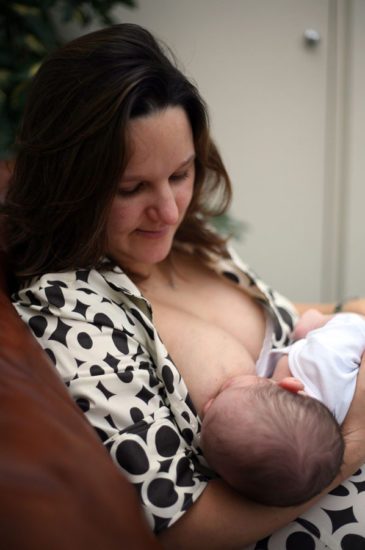Should I Feed My Baby on Both Breasts
Should a baby have one chest per feed or both sides? This commodity looks at how breastfeeding works to help understand whether a baby needs one chest or ii per feed, how often a babe might desire to breastfeed and what to do if a baby needs more milk.
Breasts make different amounts of milk
How much breast milk a breast can shop varies from mother to mother and fifty-fifty from breast to chest within the same mother. How much breast milk a chest can shop is known as the storage chapters. A female parent with a small storage capacity can make but equally much milk in 24 hours equally 1 with a large storage capacity but she volition need to feed her baby much more oft.
Size doesn't matter
It's not possible to tell how much breast milk a mother's breasts can store by looking at purely the size of the breasts considering the amount of fatty tissue will control the loving cup size. It is the amount of glandular tissue (milk making tissue) within the chest that controls the amount of milk stored between feeds. And then how tin a mother know what her storage capacity is and whether her baby needs one breast or two per feed?
One breast or 2 per feed?
Allow your babe make up one's mind! The merely person who can tell you how ofttimes he needs to feed is your baby. Only your baby knows when i chest is empty and whether he needs the milk from another chest straight away to fill him up or in half an hour or ii hours. Put some other way, if a mother can store 50ml in each breast her baby might desire both breasts per feed. Whereas the baby of a mother who stores 120ml in each breast may but want i breast per feed. You don't demand to know how much milk is stored then long as a baby is:
- fed on demand
- allowed to cease the first breast of his own accord before offering the second side (or third or fourth)
- has plenty of dirty nappies and is gaining weight appropriately and thriving
All breast milk is good
You may come beyond the thought that there are two kinds of milk in a breast; low fat foremilk at the kickoff of a feed and loftier fatty hindmilk that arrives towards the stop of a feed. Taken a step further you lot may have heard that the foremilk is like a drink or a soup starter but the hindmilk is the more important "meal" and "pudding". It can be disruptive and unhelpful to call back of breast milk in terms of two kinds of milk becauseall breast milk is good. Run into Forget Virtually Foremilk and Hindmilk to explain why you don't need to worry about this. Defoliation nearly foremilk and hindmilk can pb to harmful advice such as in the following example.
My health company told me to go on to one breast per feed to accomplish the hindmilk
Keeping to one breast "to attain the hindmilk" is a very common myth but is poor full general advice considering:
Staying on one chest can reduce a milk supply
Keeping a baby on one breast per feed—or for a specified cake of time—is by and large a manner to decrease a breast milk supply. Offering the other breast afterward your baby has finished the offset side, or switching between breasts (see box) is generally a way to increase a milk supply.
- If you lot have a low storage capacity so keeping to i chest is potentially denying your baby one-half his milk or more. Your baby may demand the "hindmilk" from both breasts.
- If you have a high storage capacity and an abundance of milk, keeping to one chest per feed, or for a cake of time,may work well.
If you are not sure whether you accept a low or high storage capacity, check with an IBCLC lactation consultant who will have a full history and check on your babe'southward weight gain and dirty nappies.
Switch nursing involves switching (irresolute) breasts a couple of times during a breastfeed to go along a sleepy baby feeding and tin can help to increase milk supply. Start by letting your baby feed on the showtime breast until their sucking slows right down or stops then move him across to the other breast. The faster flow of another allow down on the second side volition go along him interested in feeding, and so, one time sucking slows on this breast, swap dorsum to the first breast and so on. Switch nursing can be combined with chest compression; once sucking slows on each side try breast compression to keep your baby feeding actively earlier offering the adjacent breast.
An underweight baby needs more milk
When weight proceeds is an issue, the answer is almost e'er that the baby needs more breast milk rather than a few more drops of higher fatty milk from one chest:
When a babe isn't gaining weight they most probable need more milk, non more time on an already empty chest which volition further reduce a mother'southward supply. An extra 7-8 ml of high fatty milk from the same breast is no substitute for the extra 70-fourscore ml of fore-hind-and-in-the-heart-milk they might need from the other breast.
Making more than milk
Breasts make milk on need; and then that the faster your baby drinks the available milk, the faster your breasts will brand more than milk to supervene upon it, indefinitely. Breasts approximate need by their degree of fullness:
- Whenever a chest is total, milk production slows down
- Whenever a breast is emptied regularly, milk production increases
More frequent feeds, breast compressions, and using both breasts per feed are all strategies to brand more milk and see How to Make More Milk on this website.

Sometimes 1 breast, sometimes two
Let your infant determine whether he wants one breast or two per feed and whether he wants to feed again in 30 minutes or 2 hours. Get-go each new feed with the breast that baby finished on last. Breastfeeding authors Mohrbacher and Kendall-Tackett explain:
Once your milk increases on the third or fourth day, most babies have one breast at some feedings and both breasts at others. This strategy relies on your infant'south ability to tell you what he needs. As with united states adults, some babies are fast eaters and some are tedious eaters. And so a clock will never tell you when your babe is done. (How would you lot feel if, in the middle of your meal, someone pulled your plate away?) Only your babe knows for sure when the menstruum on 1 breast has slowed downward to the point where he is ready for the other side. Only he knows when he has had the correct amount of milk for that feeding.
Lopsided?
It's very common for 1 breast to accept more milk than another or for a babe to have a favourite side—perhaps they prefer one nipple over another or the flow of milk on 1 side feels just right. Over fourth dimension the favourite side will usually compensate and produce more milk while the least favourite side will slow down production. This can cause breasts to be lopsided for a while but after breastfeeding ends they will even out over again. If a mother is concerned about the size difference
- Try to recreate the same position from the favourite side on the other breast. For example if babe prefers the cantankerous cradle hold on the left side, try rugby hold on the right then that infant's torso position on that side mimics their position on the favoured side.
- Pumping with a good breast pump can help to increase the milk supply on the least favourite side—when at that place is more milk it is likely to be more desirable again to your baby.
What if my infant falls asleep at the chest? Is this a bad habit?
It is quite normal for a babe to relish sleeping in his mother'due south arms with the breast in his mouth, sometimes this is called comfort nursing. Breastfeeding your baby to sleep need not exist a problem when coupled with adept weight proceeds. Still, picket for the baby who "hangs out at the bar without ownership any drinks" i.e. he is latched on but really he is barely swallowing annihilation before getting tired and falling asleep half fashion through the first side. Consult with your IBCLC if this is the instance to get breastfeeding back on track with a intendance plan tailored for you and your infant and bank check out Breastfeeding a Sleepy Baby, Is My Baby Getting Enough Milk? or Baby Not Gaining Weight. For more information about comfort nursing see Flutter Sucking and Comfort Nursing.
I'm withal not sure when to feed him!
When your baby shows early feeding cues such equally sucking his fist or fingers, or moving his head side to side with an open mouth; offer him the breast. If you miss the early on cues he may take to cry to get your attention, but you don't take to wait for crying; babies latch best when they are calm and before they become ravenous.
Breast milk is easily and quickly digested—fifty-fifty equally quickly as 1 hour—and babies accept tiny tummies then they need to feed little and often. It is usually recommended that a baby has at least viii-12 feeds in 24 hours i.due east. that they breastfeed every two to three hours from the starting time of one feed to the start of the next and this ties in with a newborn's sleep patterns. Some babies may feed more than oftentimes e.thou. every hour at beginning. Frequent breastfeeds will provide plenty of breastfeeding practice, provide baby with a steady supply of food and stimulate the breasts to make more milk.
How can I tell my infant has finished feeding?
Check that your babe is feeding well by watching his jaw move and listening for swallows, at that place is more information in Is My Baby Getting Enough Milk? As the feed progresses his rhythmic sucking volition dull down to flutter sucks with less frequent swallows; he may fall asleep and/or permit go of the chest to signal he is finished. If yous feel he hasn't tuckered the breast properly or has fallen asleep before he finished, y'all can attempt some breast compressions to go him sucking again, when he stops sucking with the compressions, offering the second side. Sometimes he may desire the 2nd side and sometimes he might not.
Offer the chest frequently
There is a lovely passage in the Womanly Art of Breastfeeding that helps explain how often to feed a infant by comparison the breast to a snack tray:
When you're at a party, the hostess doesn't usually ask if you lot're hungry before she passes the snack tray. She offers oftentimes, and y'all decide whether to eat or laissez passer it on. You're the one with the breast "snack tray", why non be a good hostess and offer whenever your baby seems unsettled? No demand to forcefulness the issue if you've guessed wrong. But your babe can't nurse if the offer isn't made.
Isn't he just using me equally a pacifier?
Not at all! Nursing feeds him, pacifies him, puts him to sleep, comforts, reassures and relaxes him. If you offer your chest only as food and non as a "pacifier", you'll cut out all the calories he gets forth with those other reasons, you're more likely to end upwardly with supply problems, and you'll lose the pleasure of—literally—going with the flow. The phrase "he's but using you every bit a pacifier" works against confident, smooth-running breastfeeding. Nursing is how a infant grows; why agree dorsum?
Summary
Breasts vary in their breast milk storage capacities. Where one female parent's baby might merely want one breast per feed and not exist hungry for two hours, another may need both breasts per feed and be hungry once again in an hr. Let your babe decide how many breasts he wants at a item feed by looking for his feeding cues and offer him plenty of opportunities to breastfeed.
Should I Feed My Baby on Both Breasts
Source: https://breastfeeding.support/one-breast-or-two-per-feed/



